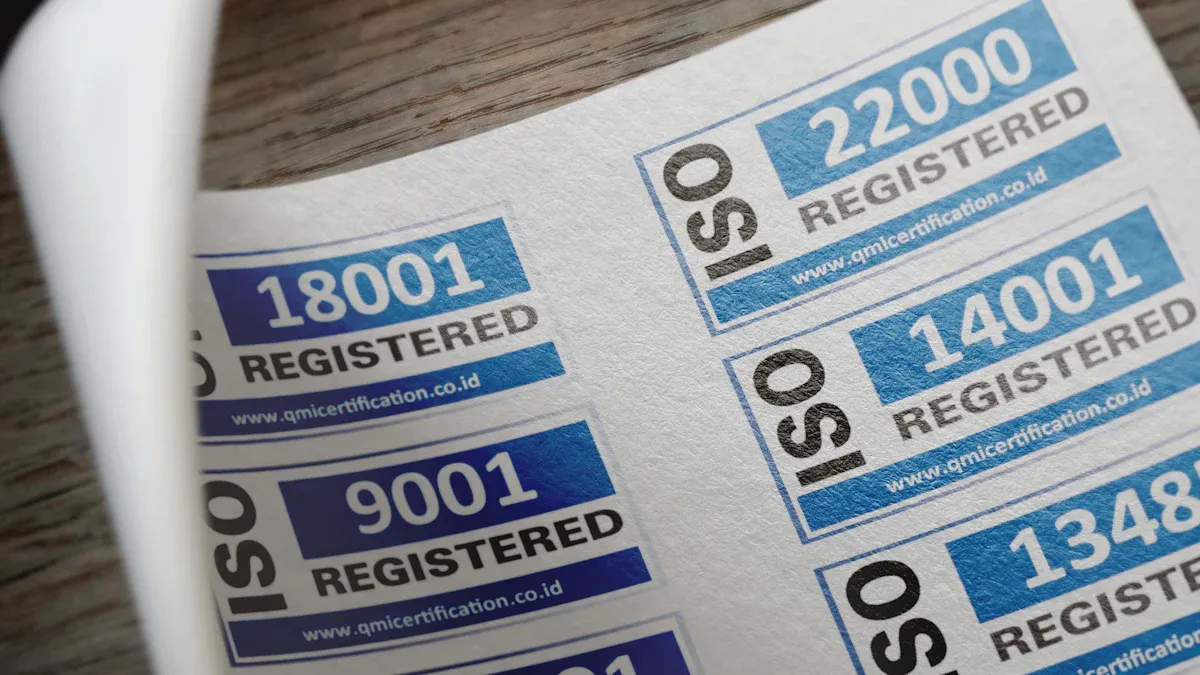Understanding Acceptable Quality Limit in Quality Control

The acceptable quality limit (AQL) is a tool for quality checks. It shows the highest number of defects allowed in products. AQL sets clear rules so only good-quality items are sold.
Today, about 65% of industries use AQL because it works well. Companies using AQL have 15% fewer product returns. They also see a 20% rise in happy customers. This proves AQL builds trust in brands and improves product quality.
Types of Defects and Acceptable Quality Limits

When checking products, defects are grouped into three types: critical, major, and minor. Each type has its own acceptable quality limits (AQL) to meet quality rules. Let’s look at these defect types and their AQL levels.
Critical Defects and Their AQL Standards
Critical defects are very dangerous for users. These defects can cause harm, so they are never allowed. For example, a faulty medical device could risk a patient’s life. To avoid such dangers, the AQL for critical defects is set between 0% and 0.25%. This strict rule ensures even a few critical defects lead to rejecting the whole batch.
Tip: Industries like healthcare and aviation use strict AQL rules for safety.
Major Defects and Their Acceptable Quality Limits
Major defects make products hard to use or work poorly. They may not be unsafe but can upset customers. For example, a chair with a wobbly leg isn’t dangerous but fails quality checks. Companies usually set the AQL for major defects between 0.4% and 0.65%.
Here’s how AQL works in real life:
Company A allows 14 major defects in 600 shirts, with an AQL of 2.5%.
Company B allows 3 major defects in 125 chairs, with an AQL of 1%.
These examples show how companies adjust AQL levels for their products and goals.
Minor Defects and Their AQL Thresholds
Minor defects are small flaws that don’t affect how a product works. These flaws are often about looks, like tiny scratches or uneven stitching. Even though minor defects are less serious, they still matter for keeping customers happy. AQL levels for minor defects depend on the product and industry.
To handle minor defects well, you should:
Use AQL tables to pick sample sizes and inspection rules.
Balance costs with quality when setting AQL levels.
Check defect data often to improve quality over time.
Fixing minor defects helps build trust in your brand and keeps quality steady.
How Acceptance Quality Limit Works
Knowing how the acceptance quality limit (AQL) works is important. AQL checks use sampling, tables, and rules to ensure quality. Let’s break down these parts.
Sampling Methods in AQL Inspections
Sampling is key to AQL checks. Instead of testing every item, you check a smaller group. This saves time and money while staying accurate.
Here are some examples of sampling in action:
OpsNinja helped an Amazon seller earn $1 million more. They improved product ratings from 3.5 to 4.7 stars using better sampling.
A study called Probability of Accepting and Rejecting shows how sampling predicts defects.
AQL C=0 plans, used by experts like Bump, flag even one defect for full batch checks.
Sampling follows AQL rules. It ensures defective items stay within limits. This keeps quality high without wasting resources.
Using AQL Tables to Set Limits
AQL tables are tools that set defect limits during checks. They help decide how many items to test and what’s acceptable. These tables make the process simple and fair.
For example, look at this AQL table:
Sample Size | Major Defect Limit | Minor Defect Limit |
|---|---|---|
200 pcs | 10 items | 14 items |
Lot Size | 3,201 - 10,000 pcs | N/A |
If you test 200 items from a batch of 3,201 to 10,000, you can allow up to 10 major defects and 14 minor ones. This keeps the batch within AQL standards.
AQL tables also give clear numbers. They show the most defects allowed, keeping quality steady. This method reduces unhappy customers and improves quality control.
Acceptance and Rejection Rules in AQL
Acceptance and rejection rules decide if a batch passes or fails. These rules depend on the number of defects found. Different industries set their own rules for safety.
Important points about these rules:
Medicines follow strict rules, like 0.25% for critical defects.
Sampling plans, like n=230 and a=0, confirm batches meet AQL.
Here’s how it works:
Test a sample from the batch.
Compare defects to the AQL limit.
Accept or reject the batch based on results.
This process matches global quality standards. Following these rules ensures good products and builds customer trust.
Practical Applications of AQL Standards

Knowing how to use acceptable quality limits (AQL) is key for quality control. This section explains how to use AQL tables, calculate sample sizes, and gives examples of AQL in action.
Step-by-Step Guide to Using AQL Tables
AQL tables make product checks easier. They show how many items to inspect and the defect limits. Follow these steps to use them:
Find the Batch Size: Count all items in the batch. For example, 1,000 items is your batch size.
Pick the AQL Level: Choose the defect limit based on your industry. Medicines often use stricter levels than clothing.
Use the AQL Table: Look at the ANSI ASQ Z1.4 table to find the inspection level and sample size code for your batch.
Get the Sample Size: Match your batch size and AQL level to find how many items to check. For example, inspect 80 items from a batch of 960 units.
Do the Inspection: Check the sample and count the defects.
Decide on the Batch: Compare defects to the AQL limits. Reject the batch if defects are too high. Accept it if they are within limits.
Tip: Check your inspection process often to keep quality steady and find ways to improve.
Calculating Sample Sizes for AQL Inspections
Finding the right sample size is important for good checks. AQL tables help you do this step by step. Here’s an example:
Level | Sample | AQL Critical | AQL Major | AQL Minor |
G-II | 80 | 0.0 | 2.5 | 4.0 |
Max Allowed | 0 | 5 | 7 |
Use Table 1 to find the inspection level. For 960 units, the range is 501-1200. At level II, the code letter is J.
In Table 2, find code letter J. It shows you need to inspect 80 items.
Check the sampling table for defect limits. For 2.5% (major defects), allow up to 5 defects. For 4.0% (minor defects), allow up to 7 defects.
These steps make inspections simple and accurate.
Real-World Examples of AQL Applications
Many industries use AQL to keep products high-quality. Here are some examples:
Industry | AQL Set | Defects Found | Action Taken |
|---|---|---|---|
2.5% (major), 4.0% (minor) | 12 major, 22 minor | Production process reviewed for major defects. | |
Electronics Assembly | 1.0% | 1.2% | Batch rejected; soldering process analyzed. |
Pharmaceuticals | 0.1% | 0.15% | Production stopped; safety investigation started. |
Automotive Parts | 1.5% | 1.6% | Molding process improved with corrective actions. |
For example, in textiles, a batch with 12 major and 22 minor defects failed AQL limits. This led to fixing production issues. In electronics, a batch with 1.2% defects was rejected because it passed the 1.0% limit. These examples show how AQL stops bad products from reaching customers.
Note: Using AQL rules often can lower returns and make customers happier.
Benefits and Limitations of Acceptable Quality Limits
Advantages of Using AQL Standards
AQL standards bring many benefits to production and customer happiness. They help find and fix defects, keeping product quality steady. Here’s a simple look at the main advantages:
Metric/Benefit | Description |
|---|---|
Cuts costs by reducing defective items and wasted materials. | |
Time Savings | Saves time by lowering rework and inspection efforts. |
Improved Quality | Ensures products meet standards, making them better and more reliable. |
Consistency | Keeps quality the same across all products, meeting customer needs. |
Compliance | Helps companies follow rules and quality guidelines. |
Customer Satisfaction | Builds trust and improves brand image by delivering good products. |
Using AQL makes inspections easier, reduces waste, and boosts your brand’s trustworthiness. These benefits make AQL a key part of quality control.
Challenges and Limits of AQL
Even though AQL works well, it has some downsides. One problem is it checks only samples, not every item. This can miss defects, especially in small batches. Also, setting AQL limits too high or low can hurt efficiency or upset customers.
Another issue is that some businesses lack resources for proper checks. Small companies may not have enough staff or time for inspections. Plus, AQL focuses on finding defects, not fixing their causes.
Knowing these challenges helps you improve your quality control plans.
Ways to Solve AQL Problems
You can fix AQL’s issues by following smart practices. Start by writing detailed notes during inspections. This helps spot patterns and differences in batches. Flexible ways to collect data also make it easier to adjust to changes.
Strategy | Description |
|---|---|
Study each case to find patterns and understand differences. | |
Flexible Data Methods | Use adaptable tools to collect detailed information about defects. |
Also, keep clear records of every inspection step. This ensures transparency and makes tracking easier. Use organized methods to sort and study defect data. These steps not only solve AQL’s problems but also improve your quality checks.
Tip: Check your AQL process often to match your goals and customer needs.
FAQ
What does AQL do in quality control?
AQL sets the highest number of defects allowed in a batch. It helps make sure products meet quality rules and please buyers. Using AQL keeps products consistent and avoids expensive returns.
How do you pick the right AQL level?
Choose the AQL level based on your product and industry. For example, medical tools need stricter limits than clothes. Use AQL tables to find the best match for your needs.
Can AQL checks promise no defects?
No, AQL checks only test samples, not every product. They lower defects but can’t remove them all. Combine AQL with other methods to get better results.
What if a batch fails an AQL check?
If a batch fails, reject it or fix the problems. You might review how it was made, repair flaws, or check it again. This ensures customers get only good-quality items.
Are AQL rules the same for all industries?
No, AQL rules differ by industry. Fields like healthcare and aviation have stricter limits. Everyday goods, like clothes, may allow more defects. Adjust AQL to fit your industry’s needs.
See Also
Decoding MSA: Insights Into Measurement System Analysis
The Importance of QRQC in Today's Quality Control
Understanding PPAP: A Cornerstone of Quality Manufacturing
SPC Uncovered: Enhancing Production Through Statistical Process Control
Essential Reads on Quality Management Techniques and Tools
About Hunan Puka
Established in 2016 and based in Hunan, China, with a liaison point in Berlin, we are a Tier 2 supplier for the automobile industry. We specialize in the production of customized aluminum die-casting parts designed for machines with a closing force ranging from 280 to 1250 tons, with subsequent manufacturing process CNC machining and surface treatment. Our commitment to quality is reflected in our accredited quality management system, certified by ISO9001:2015 and IATF16949:2016 standards.


